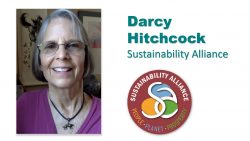Sherab Khandro Sacred & Contemporary Art has received Innovator/Silver Sustainable Business Certification
February 17, 2021
 Sherab Khandro’s art, inspired by her Tibetan Buddhist practice, could be considered an expression of sustainability. Her Bodhisattva vow informs her philosophy of living. This is a commitment by Buddhists to return again and again until all suffering has come to an end. For Khandro, “Each stroke of the brush holds a prayer of compassion. Each dot is offered as a jeweled universe, a prayer to end suffering in the world.” She’s currently Artist in Residence with the Goldenstein Gallery (now in L’Auberge).
Sherab Khandro’s art, inspired by her Tibetan Buddhist practice, could be considered an expression of sustainability. Her Bodhisattva vow informs her philosophy of living. This is a commitment by Buddhists to return again and again until all suffering has come to an end. For Khandro, “Each stroke of the brush holds a prayer of compassion. Each dot is offered as a jeweled universe, a prayer to end suffering in the world.” She’s currently Artist in Residence with the Goldenstein Gallery (now in L’Auberge).
But sustainability is also integral to her business operation. “Sustainability is a core conversation in the company and with our collaborators,” she explains, for example, by showing contractors and other artists how to reduce and recycle waste streams. Her company hosted “Sustainable Saturdays” discussions on Facebook and plans to increase social media sustainability messaging.
Climate and Energy
Khandro’s studio is in the West Sedona home she rents, where she keeps a close eye on energy use. “We signed up for APS’s Time of Use plan, so we try to use our appliances when energy is less in demand and less expensive.” The house is new so all appliances are energy efficient. She traded in her gas-guzzling 4×4 for a more energy efficient SUV which is still large enough to transport her art.
She places a lot of attention on materials reuse, which saves energy. “I enjoy making sure everything is used to the fullest.” She saves packaging material, sorting it for reuse. She uses recycled materials whenever possible, like the recycled paper in her cards. Jewelry is cast in sterling and bronze, and all unused metal is returned to casting foundry. Her desk is an old Baker’s Scaffolding 6’x3’ with reclaimed wood. Her work surface is a drafter’s “flat file” purchased used and refinished, which doubles as storage.
She sources materials and services as close to home as possible. For example, casting is done locally in Sedona. Printing is done in Phoenix but prints are stretched locally. Her paints are from California and jewelry findings are sourced from New Mexico.
“Air quality is a high priority for me and those who work with me,” Khandro explains. Art can sometimes be a dusty, smelly practice. “I’ve been doing this work for 30 years and learned the hard way about air quality risks and how to mitigate them.” She makes sure the space is well ventilated and provides respirators when appropriate. But that is only a partial solution. She continues to seek safer alternatives. “For example, we no longer use polyester resins; instead, we moved to a rubber mold with a gypsum shell and we use acrylic paints to reduce emissions.”
Natural Resources
Khandro is proud that they didn’t cut down a single tree or replaced plants when building the house where she lives. The landscaping is all native and currently there isn’t even an irrigation system. The house was built to be sustainable so it’s both energy- and water-efficient. But still, she watches her water use like a hawk.
Employment Practices
While she is self-employed with no employees, she does use independent contractors. “I make sure we pay well above minimum wage. Jewelry contractors can work from home and set their own hours.” She also tries to provide a variety of interesting work tasks and encourages them to develop their skills.
Sherab Khandro, through Sacred & Contemporary Art, also gives back to the community. “In recognition of the International Day of Peace in September, we sponsor ‘Follow the Peace Trail’ events as a way to support not-for-profit and for-profit organizations supporting a more peaceful and compassionate world.” Khandro also donates art and jewelry to support fundraisers for numerous local non-profits.


